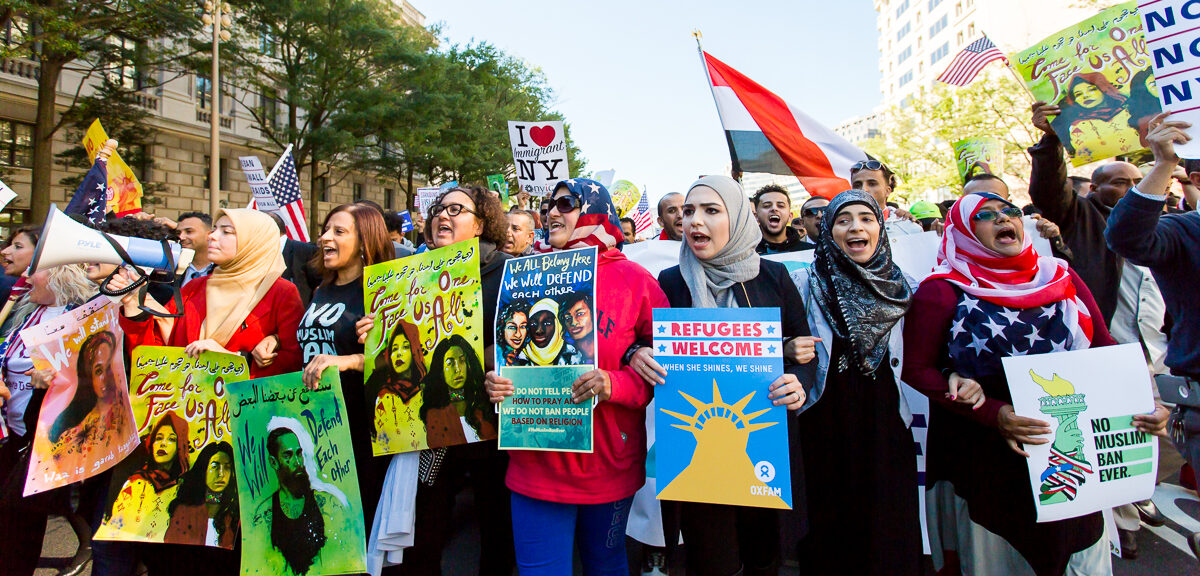Feb
4
2021
Written by Deepa Iyer (Director of Strategic Initiatives)
Four years ago this month, I was facilitating strategy conversations about the Muslim ban, an executive order issued by the Trump Administration that led to family members separated from each other, massive protests at airports, and a slew of lawsuits. I wasn’t alone. Across movements and communities, many organizers, frontline responders, and advocates adopted a stance of vigilance and resistance given the relentless attacks on the rights of marginalized people. Now, we are in a different moment. Even if we are not in constant rapid response mode as we were over the past four years, we have much to do as social change organizations and advocates.

What lessons can we draw upon from the past four years to sharpen and strengthen our collective work towards justice and equity? We offer four recommendations below:
Take the Steps between Resistance and Rebuilding: Switching from a posture of constant vigilance to a stance of rebuilding can’t happen automatically. There are several steps along the way including reckoning and repair. A reckoning requires both an accounting of harm, a process of accountability, and the space for transformation. For example, we are hearing calls for reckoning now in terms of the impeachment of Donald Trump and accountability for the January 6th insurrection.
Repair mends the wounds and polarizations that exist in our society. We can see repair happening in the reversals of divisive Trump Administration policies. In the first 24 hours after President Biden and Vice President Harris took office, the White House issued 17 executive orders on issues ranging from reversing the Muslim ban to revoking the permit for the Keystone XL pipeline and centering racial equity as a guiding principle across the federal government.
What is taking the place of these recissions and reversals? That’s where rebuilding comes in, a process by which we center bold and intertwined solutions for our collective futures, rather than incremental changes that occur in silos. For example, the Movement for Black Lives is calling for far-reaching economic solutions given the pandemic’s effects on Black communities. The Detention Watch Network is focused on ending immigration enforcement and protecting immigrants who are exposed to the virus in ICE detention jails. The Sunrise Movement is demanding that policymakers prioritize climate action in all decisions moving forward. These are bold and big solutions that communities deserve. [Watch the “Black Futures” video that imagines how the summer of 2020 paved the way for the future, from the Movement for Black Lives and Root Story Films here].
It is important to not rush the process between resistance and rebuilding. We can’t afford to skip steps, especially if we work alongside with or on behalf of people who experienced direct trauma related to the policies and rhetoric of the past four years. These conversations are important ones to have at every level, including within our organizations and movements.
Nurture our Newly Formed Ecosystems: Over the past four years, organizations and movements came together strategically to push back against hostile policies. Rapid response networks and coalitions emerged quickly. New organizations were launched to address the needs of their communities. Four years later, our social justice ecosystems are much more diverse with the formation of cross-community and cross-issue coalitions at local and national levels. Even if we aren’t working with the same level of urgency, it is important to sustain these ecosystems for the long run. How can rapid response formations envision affirmative policy advocacy? How can philanthropy invest in these networks for the long run?
Strengthen Solidarity Practices: In the wake of the pandemic and the uprisings of 2020, it became clear that the ties that bind us together are what kept us afloat. People and organizations demonstrated solidarity by holding vigils and rallies in the wake of the murder of George Floyd, by creating mutual aid associations at the neighborhood level, and by opening up discussions at their organizations about how to confront anti-Black racism with urgency.
When we strengthen our solidarity practices, we build connections and recognize commonalities with each other. We center the needs and solutions of those directly affected by oppression. We show up as people and organizations who are in service to co-liberation – justice and freedom for everyone. How can our organizations express our solidarity values? How can networks and coalitions advocate for policies in the first 100 days and the next four years of the new Administration using a solidarity lens?
Recommit to Our Individual and Organizational Roles: In times of crisis, many organizations move into the roles of disrupters and frontline responders. BMP’s report on the pandemic and the uprisings against anti-Black racism in 2020 found that many people-of-color led nonprofits pivoted into playing the role of first responder to fill gaps in order to address basic survival needs while others played the role of a disrupter to address anti-Black racism within non-Black communities of color. When we are not on high alert, how can we reimagine our roles in our social change ecosystems? Perhaps we can be storytellers to document and archive the effects of the past four years on our communities. Or, we can be weavers if we have access to resources in order to target resources to communities across the country. Or, we can be builders who set up a foundation for rapid response now when things are calmer so that we can rely on them in the future. Or, we can be healers who help us move through the process of resistance to rebuilding. There are many roles each of us can play as the landscape and energy around us shifts.
By holding fast to the lessons from the past four years and by going through a process of reckoning, repairing, and rebuilding, we can participate in today’s new landscape with a sense of renewed purpose and commitment.
We offer two tools that might be helpful in your own process of moving from resistance to rebuilding: the social change ecosystem framework available here, and the movement pantry (in collaboration with Trish Tchume), available here.

